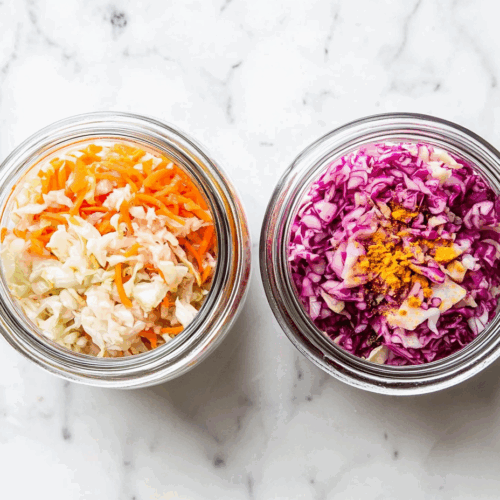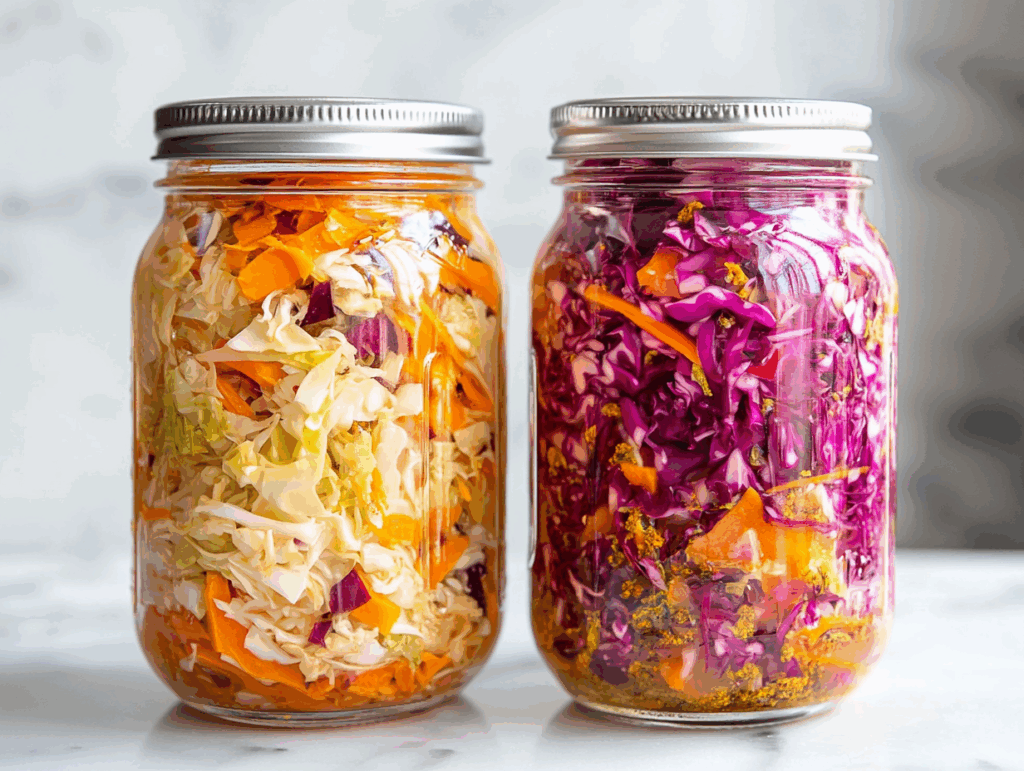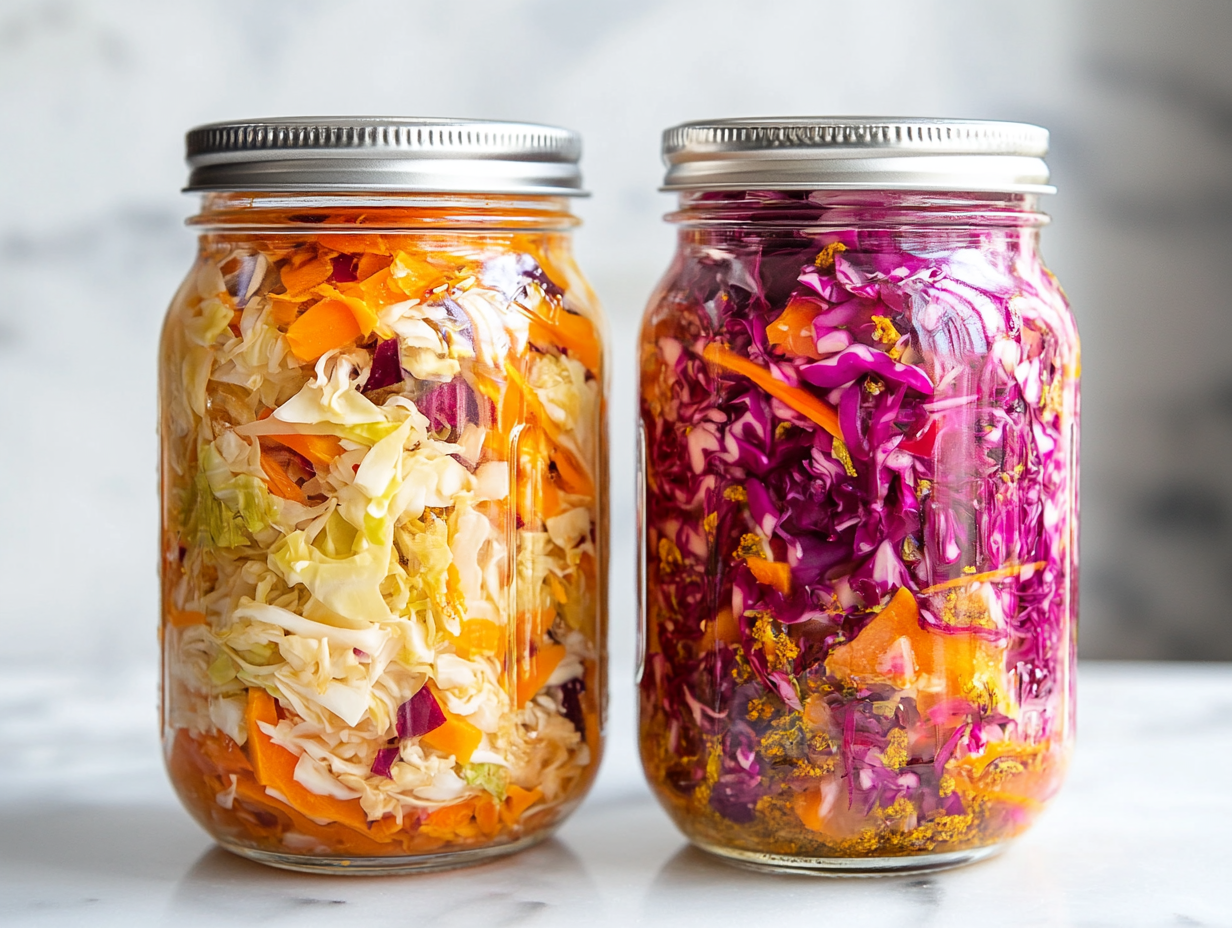Making your sauerkraut at home is a breeze and it’s super good for your gut! It’s the perfect addition to any meal and once you try it, you’ll want to put it on everything – seriously, it goes well with just about anything, from meatloaf to pizza. Plus, it’s awesome to have a healthy side dish ready in your fridge whenever you need it.
I’ve talked about the benefits of probiotics before, like in my post about Raw Organic Milk Kefir. They’re great for boosting your immune system and keeping your digestion on track. The best part? Making your own sauerkraut is way cheaper than buying probiotic pills.
For just a few bucks, you can grab some cabbage and whip up a batch to enjoy with dinner. And don’t worry if you’ve never fermented veggies before – it’s not as scary as it sounds! With just a few simple ingredients, you’ll have delicious homemade sauerkraut in no time.

Sauerkraut Recipe
Equipment
- Mixing bowl
- Knife
- Sterilized Jars
Ingredients
- 8 cups Red or green cabbage finely grated or chopped
- 1 ½ – 2 tsp Sea salt plus more to taste
- 1 small Beet finely shredded
- 3 whole Carrots finely shredded
- 3 Tbsp fresh Ginger shredded/grated
- 3 Tbsp fresh Turmeric shredded/grated
- 4 cloves Garlic finely minced
Instructions
- Sterilize jars and equipment by pouring boiling water over them, then dry completely. Let them cool to room temperature.
- Add finely grated cabbage and 1 ½ teaspoons sea salt to a large bowl. Massage cabbage with clean hands for 10 minutes until it softens and releases water.
- Add shredded beet, carrot, ginger, turmeric, and garlic. Massage again for 4-5 minutes until well combined.
- Taste and adjust flavor with more salt, ginger, or garlic if needed.
- Pack the mixture firmly into sterilized jars, ensuring the liquid covers the vegetables. Add filtered water if necessary.
- Leave about 1 ½ inches of space between the contents and the lid for expansion. Seal with a lid.
- Place jars on the counter away from direct sunlight or in a cabinet. Keep the temperature above 65°F (18°C) for proper fermentation.
- Open jars daily to release air and press vegetables down to keep them submerged in liquid.
- Fermentation can take 24 hours to 2 weeks depending on the temperature. Taste periodically to check tanginess.
- Once desired tanginess is achieved, secure the lid and transfer the jars to the fridge. Sauerkraut will keep for 3 to 6 months. Avoid double-dipping when serving to prevent contamination.
Notes
- Use Fresh Ingredients: Fresh vegetables and spices give the best flavor and texture.
- Even Slicing: Use a mandolin slicer to get uniformly thin slices of cabbage for even fermentation.
- Temperature Control: Keep the jars in a warm spot, but out of direct sunlight, for the best fermentation.
Nutrition Facts:
| Nutrition | Value |
|---|---|
| Calories | 65 kcal |
| Carbohydrates | 7g |
| Protein | 1g |
| Vitamin A | 108IU |
| Vitamin C | 45mg |
| Iron | 1mg |
| Sugar | 4g |
| Calcium | 43mg |
How Long Does It Take to Make Sauerkraut?

It takes about 30 minutes of prep time and then about a week to ferment. However, fermentation time can vary depending on the temperature of your home.
How Long Does Sauerkraut Take to Ferment?
Fermentation time can range from 5 days to 3 weeks. It depends on factors like room temperature and desired tanginess.
How Long Does Fermented Sauerkraut Last?
Properly prepared and stored sauerkraut can last at least around 6 months in the refrigerator. Look for signs of mold, ensure the colour is even, and check for a good texture and smell before consuming.





